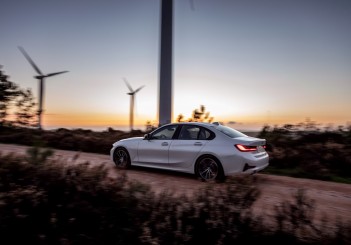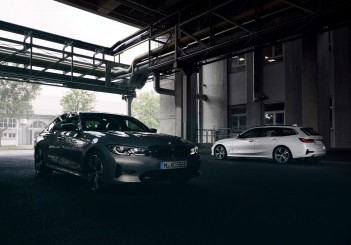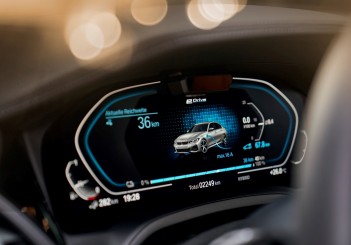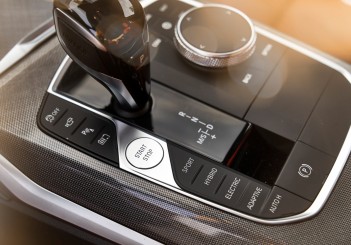Making its debut appearance in a BMW, the standard-fitted XtraBoost raises the system output of the plug-in hybrid to a maximum 292hp and an electric range of over 50% more than its predecessor at 66km.
Fuel consumption and emissions are down by more than 15% over its predecessor - from 1.9 to 1.6 litres per 100 kilometres and 43 – 37 grams of carbon dioxide (Co2) per kilometre.

The plug-in hybrid system pools the abilities of a 2.0-litre turbocharged engine with 184hp and an electric motor that generates 113 hp. Together, the two drive sources produce maximum system torque of 420Nm.
A brand-new feature – and included as standard in the new 330e – is XtraBoost and come quickly into play by activating Sport mode via the Driving Experience Control switch.
A vigorous stamp on the accelerator uncorks an additional 40hp (for up to 10 seconds) on top of the combined 252hp already generated by the combination of the electric motor and combustion engine while being managed by an eight-speed Steptronic transmission including engine-braking downshifts and a specific shift program.
The instant-impact XtraBoost delivers a significantly more intense experience of acceleration than a conventionally powered vehicle with comparable output could offer.

For example, if the driver suddenly puts their foot down hard from 20kph, in as little as a second the 330e accelerates with around twice the vigour of a car powered solely by a combustion engine.
Within three seconds, it opens up a car’s length gap and the XtraBoost can still be accessed with the high-voltage battery at a minimum charge, as well as in kickdown and with the transmission selector lever in M(anual) or S(ports) position.
The new 330e sprints from 0 to 100kph in 5.9 seconds before reaching a top speed of 230kph.
The driving experience is accompanied by a drive system note, which finds its way into the interior.
In Hybrid driving mode, the new 330e can reach speeds of up to 110kph in pure electric mode – an increase of 30kph over its predecessor while Electric mode allows for speeds of up to 140kph - up from 120kph.

Hybrid-specific standard features of the new 330e include acoustic pedestrian protection. When driving in electric mode, an exterior speaker system generates a sound created specifically for electrified BMWs.
At low speeds, the drive system’s bespoke note exudes aural presence, without impinging on the acoustic comfort of those on board.
The new 330e's electric motor is integrated into the eight-speed Steptronic transmission to saving space just as before and also comes equipped with braking energy recuperation.
With a gross energy content of 12kWh, the lithium-ion (li-ion) high-voltage battery mounted under the rear seats allows for an increase in electric range of more than 50% over its predecessor of 59 to 66km.
Meanwhile, the second generation of the plug-in hybrid sports sedan cuts fuel consumption and emissions by over 15 per cent to 1.9 – 1.6 litres per 100km and the combined-cycle electric power consumption resides at 15.4 to 14.8kWh per 100km.

The battery limits the boot capacity of the 330e to 375 litres which can be expanded via the 40:20:40 split-folding rear backrests.
The new 330e can be had in four trims that include Advantage, Sport Line, Luxury Line or M Sport as an alternative to the basic specification and can be further kitted with optional equipment such as an Adaptive M suspension system with variable sport steering and M Sport brakes.
From November, the 330e will be made available with a trailer coupling with electrically pivoting hitch ball that has a maximum trailer load of 750kg.
Standard specification for the new 330e includes preconditioning of the interior with the heating or air conditioning while optional equipment includes Driving Assistant Professional with steering and lane control assistant and Parking Assistant including reversing assistant is also available.
The Energy stored in the high-voltage battery is used to power the auxiliary heating. During low external temperatures, the interior can be warmed up prior to entering the car - even when the battery charge is low. This interior preconditioning function also allows the interior to be cooled during higher ambient temperatures.
New digital services will be presented which makes charging the battery during a journey even easier and more attractive.
Selecting a public charging station prompts the navigation system to come up with recommendations on nearby hotels, restaurants, cafés and sights or cultural centres as well as check the locations of other charging stations via the display and control system.

The driver can likewise check the predicted availability of public charging points at the time of arrival as well as reserve a charge point for a limited time, should it be offered by the charging infrastructure operator.
The same powertrain can be had in the upcoming 330e Touring (wagon) by mid-2020 - a first for a BMW Touring model.
The new BMW 330e Sedan is ready to take advantage of low-emission zones designated by cities exclusively for zero-emission driving.
With the new BMW eDrive Zones function (which will be part of standard equipment for BMW plug-in hybrid models from 2020 and can be retrofitted), geofencing technology will make it possible to detect low-emission zones automatically.
When entering these zones, the vehicle switches into pure-electric driving mode automatically, from which point it behaves like a fully-electric vehicle and can, therefore, enjoy equal access rights (subject to local regulations).

The increase in the proportion of journeys driven on electric power not only plays a role in optimising efficiency but can help to reduce operating costs for customers.
This applies to driving in urban areas, in particular, where an electric drive system delivers a higher level of efficiency across the board than a petrol or diesel engine.
The “real” environmental impact of plug-in hybrid vehicles has been questioned on occasion, especially in markets where the proportion of green energy used by the public energy grid remains small.
BMW Group conducted a full-cycle CO2 certification for the new 330e – from raw material procurement, supply chain, production and use phase, all the way to recycling.
This revealed its CO2 footprint is now 20% smaller than the new 330i Sedan when running on average European power in the use phase. When charging the car with green energy, its CO2 footprint is reduced by as much as 60%.
































